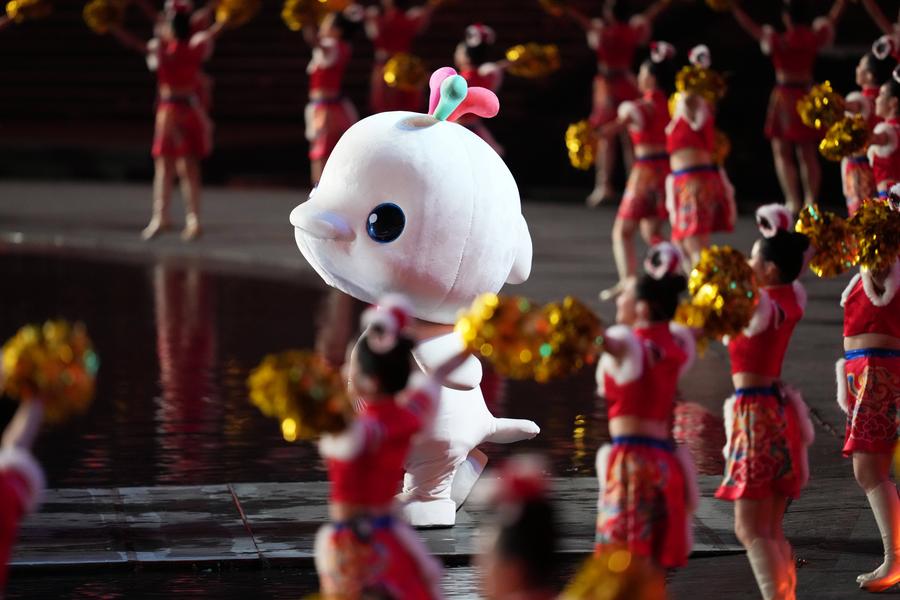


The mascot is seen during the opening ceremony of China's 15th National Games in Guangzhou, south China's Guangdong Province, Nov. 9, 2025. (Xinhua/Li Yibo)
GUANGZHOU, Nov. 13 (Xinhua) -- Outside roaring stadiums hosting China's ongoing 15th National Games, two mascots with fluffy round heads and chubby bellies have captured both the nation's heart and its bandwidth.
Resembling playful, anthropomorphized chicks, this duo -- mistakenly dubbed the "greater bay chicks" by netizens, has hatched a social media frenzy of memes and clips chronicling their every bounce and mischief, amassing 640 million views on Douyin, a popular short-video platform in China.
In reality, the "greater bay chicks" are none other than the official mascots of China's National Games, named Xiyangyang and Lerongrong. Far from being inspired by chickens, their design draws from the Chinese white dolphin -- a rare species known as the "panda of the sea."
The animal, thanks to efforts made by China in ecological and environmental protection, can now be found year-round in the waters of the Greater Bay Area -- one of China's most dynamic regions linking Guangdong, Hong Kong, and Macao.
The National Games, which opened on Sunday in Guangzhou, the capital of Guangdong Province, is China's largest-scale and highest-level multi-sport event, jointly hosted for the first time by the three places.
Liu Pingyun, dean of the School of Visual Arts Design at Guangzhou Academy of Fine Arts and head of the design team, said that it was a deliberate decision to choose the Chinese white dolphin as the mascots of this year's event.
The Chinese white dolphin highlights the region's harmony between human and nature, embodies the spirit of unity, perseverance and striving inherent in athletes, and carries a deeper symbolism of national identity and aspirations for reunification, Liu explained.
Rich symbolism of the GBA is embedded in the design of these mascots. For example, the three-colored water spouts atop their heads, often mistaken for a "chicken comb," actually represent the flowers of the host cities: Guangzhou's kapok, Hong Kong's bauhinia, and Macao's lotus. Viewed from the front, the water spouts form a heart, symbolizing unity.
Liu said he was delighted to see people giving Xiyangyang and Lerongrong new nicknames and meanings inspired by their own lives and experiences.
The design philosophy itself encouraged such public engagement. A mascot is a cultural IP that creates strong emotional connections, Liu said. "Our design philosophy was to leave room for public co-creation, allowing the narrative to unfold through the audience's own imagination," he added.
The shift in mascot design can be traced right from the Fuwa of the Beijing 2008 Summer Olympics, to Bing Dwen Dwen of the Beijing 2022 Winter Olympics, and now to the popular "greater bay chicks." Chinese mascots have gradually transformed from highly symbolic icons into relatable companions -- open to engagement and reinterpretation.
What has made the dolphin mascots so popular is not only their cute appearances, but also the energetic, adorable and sometimes naughty performances of these mascots during competitive events at the Games. Their playful antics -- including the likes of bouncing, doing handstands and even kissing, have delighted spectators both in stadiums and online.
Their lively charm is no accident. Remarkably, performers inside the mascot suits at the Games are teenage students from martial arts schools. To bring the mascots to life via agility and precision, the students underwent nearly five months of specialized training, in which they practiced movements like rotating, jumping, and swinging arms for thousands of times with a costume weighing as much as eight kilograms. Their solid martial arts skills and cheerful natures have truly infused the mascots with vigor and vibrancy.
This widespread appeal is also serving as a powerful economic driver. Mou Hong, a tourism management professor at Chongqing University of Technology in southwest China, voiced confidence in the substantial potential of IPs like the "greater bay chicks" for tourism and economic development.
As these mascots have won over netizens, the online buzz has gradually translated into economic benefits through themed merchandise. Official figures show that in total -- over 2,800 licensed products have been developed for the Games, which are available at more than 700 physical retail outlets and in over 70 online stores.
Among the most sought-after items are Chinese zodiac-themed blind boxes and lion dance ornaments -- all featuring Xiyangyang and Lerongrong. The Chinese zodiac blind boxes, in particular, with an original price of 89 yuan (about 13 U.S. dollars), have sold out both online and in stores.
Since 2024, a series of Chinese cultural and creative products have become breakout hits and trending topics online. Some well-known IPs, such as Nezha, Wukong, and Labubu, have raised waves of consumption craze through films, games, and various cultural derivatives, both at home and abroad.
"The success of these popular items stems from not only possessing a clear cultural core, modern design, and fine craftsmanship, but also from aligning with the evolving demands of modern Chinese consumers," said Hu Yu, head of the Institute for Cultural Creativity at Tsinghua University.
点击右上角![]() 微信好友
微信好友
 朋友圈
朋友圈

请使用浏览器分享功能进行分享
